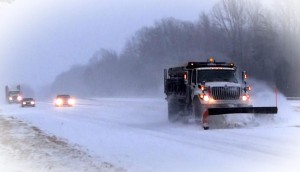
I am a chemist. I live where it snows a number of times each year. Road safety requires local transportation departments to plow during storms. Their efforts are enhanced if preparation is made beforehand. One way to accomplish this is by spraying roads ahead of time with anti-icing spray.
Sand
Spreading sand does help traction, but it doesn’t prevent or eliminate ice. There is another reason to use something besides sand. Has the reader heard of sandblasting? Particles of sand are blown against a surface to clean it. In fact, it is used to blast away paint from a painted surface. Is that what you want for your automobile?
Salt and Calcium Chloride
Rock salt or halite (NaCl) has commonly been used to remove snow. Another compound frequently used is calcium chloride (CaCl₂). These compounds can accomplish the job. But they are not as good as magnesium chloride (MgCl₂). NaCl and CaCl₂ attack the metal surfaces of cars and bridges. They affect the environment. In fact, a war enemy might spread salt to make land unsuitable for use¹.
Magnesium Chloride
Magnesium chloride solution is applied before a snow begins. The water evaporates, leaving a white film on the road. Snow melts at 0º Celsius (32º Fahrenheit). However, magnesium chloride depresses the freezing point of water. So any water forming at the boundary between snow and the road does not so quickly turn to ice. This makes road cleaning easier and driving safer. Magnesium chloride is less harsh on cars, bridges, and the environment.
¹ compare the Bible, Judges 6:45.
Resources:
- Antoine: Frostburg University: Why does salt melt ice?
- Idaho Transportation Department: [Anti-Icing Spray]